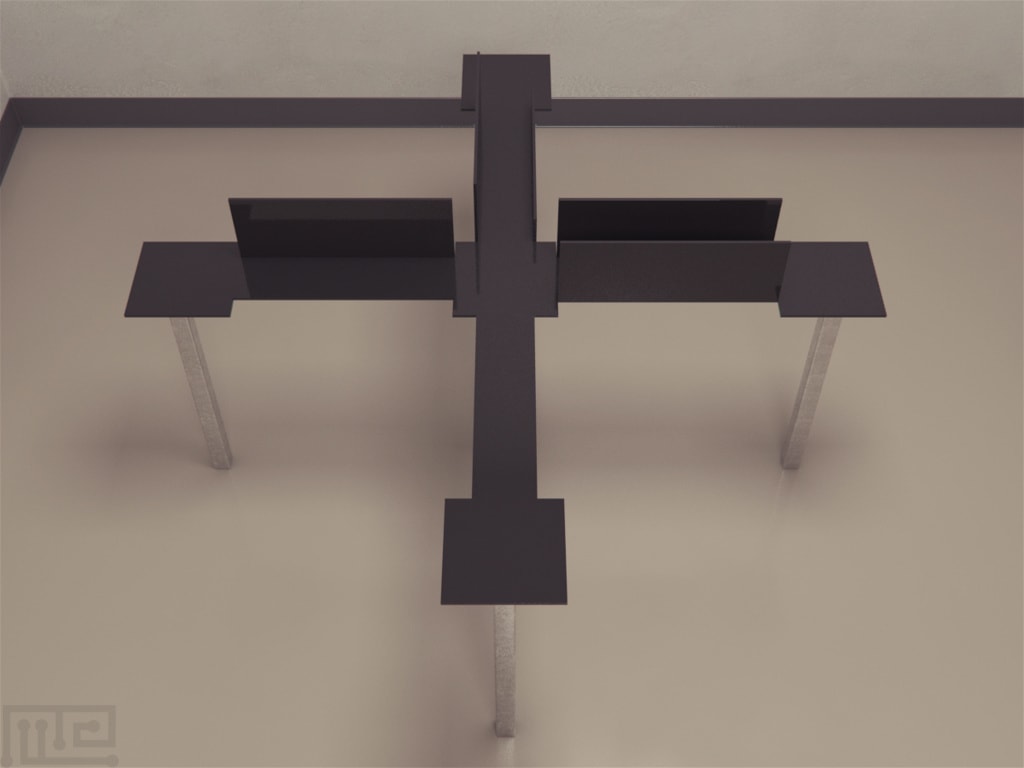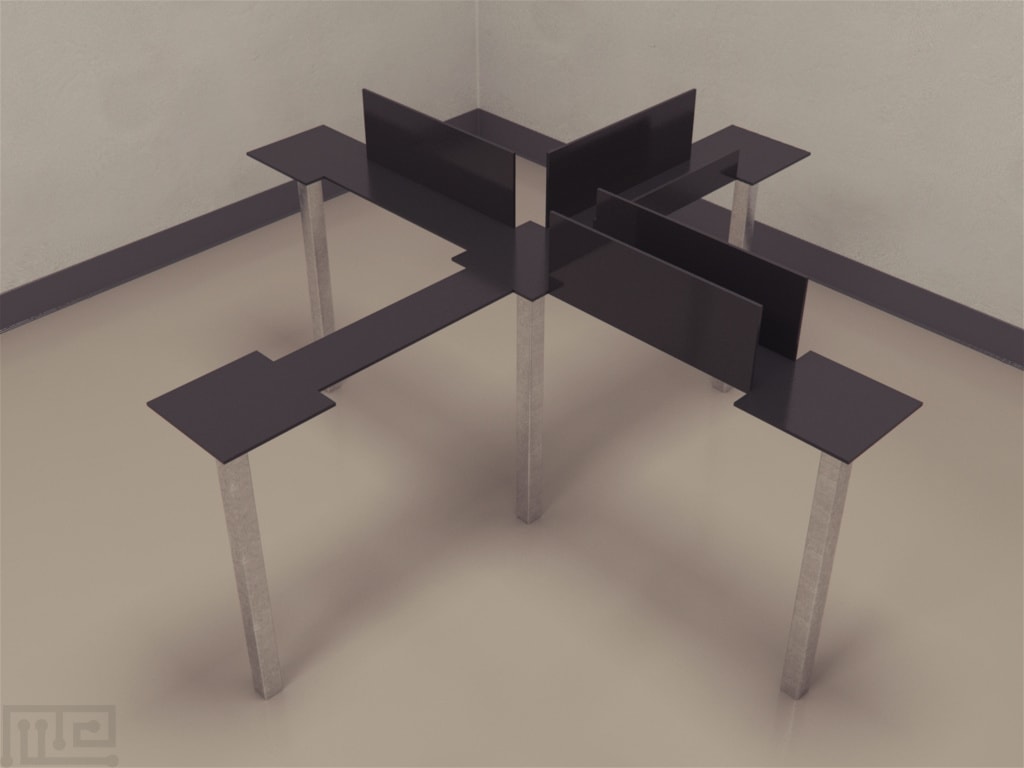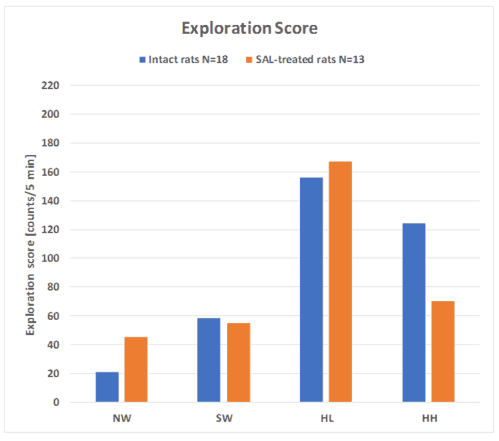The Elevated Asymmetric Plus maze is an apparatus first described by Ruarte et al (1997) as a method to encourage explorative behavior in the rat.
The apparatus consists of an elevated asymmetric plus-maze composed of 4 different arms of the following specifications:
Arm 1: no walls
Arm 2: Single high wall
Arm 3: high and low walls
Arm 4: two high walls
Price & Dimensions
Mouse
$ 2290
Per Month- Length: 32 cm
- Width: 8cm
- Central Platform: 15cm x 15cm
- High Wall: 11cm
- Low Wall: 4cm
- Elevation: 45cm
Rat
$ 2390
Per Month- Length: 42 cm
- Width: 11 cm
- Central Platform: 20cm x 20cm
- High Wall: 15cm
- Low Wall: 6cm
- Elevation: 60 cm
Are you an academic scientist and creator?
Learn how your lab can tech transfer this and similar devices from your lab to industry.
Documentation
Introduction
The Elevated Asymmetric Plus Maze is used in the assessment of the mechanisms of exploratory motivation and fear in rodents. The maze was first described by Ruarte et al., 1997, in their paper investigating the role of histamine in the hippocampus in exploratory motivation mechanism and emotionality. The maze features different asymmetries on each arm by using a combination of walls and no-walls. The design was intended to create conflictive exploration among the subjects. The basis of the approach was that novel environments with fear-inducing characteristics induce specific behaviors and modulate exploration by fear.
The Elevated Asymmetric Plus Maze is a modification of the traditional Elevated Plus Maze with four different asymmetries on each arm: no-wall arm, high walls arm, high-low walls arm and no-wall arm. The difference in geometrical characteristics of each arm creates a conflict with the natural explorative tendencies of the rodents. The Asymmetric Plus Maze is ideal for studying drug effects on the explorative behaviors and for quantifying anxiety.
Apparatus and Equipment
The elevated Asymmetric Plus Maze is a ‘+’ shaped maze with each arm being geometrically different from one another. Each arm is 42 cm in length and 11 cm wide with a platform (20 x 20 cm) at their ends. The asymmetries of the arms are as follows.
- Arm with no wall (NW)
- Arm with a single wall of height 15 cm (SW)
- Arm with 2 walls, one of which has a height of 15 cm and the other 6 cm (HL)
- Arm with 2 high walls of height 15 cm each (HH)
The entire maze is maintained at an elevation of 60 cm from the floor. The maze is usually black in color.
Training Protocol
The Asymmetric Plus Maze is cleaned before and after every trial to avoid unnecessary stimuli from influencing the performance of the subjects. The entire apparatus is well-lit. For tracking and recording, software such as the Noldus Ethovision XT can be used.
Since the aim of the investigation is to assess novelty-based exploration, each subject is only tested once in the maze. In case of drug testing that requires implants, the implantation is done at least 72 hours before the experiment to allow enough recovery time.
The general procedure of the task involves placing the subject on the central platform and observing its exploratory behavior for 5 minutes.
Evaluation of the effects of hippocampal implant procedures on the behavioral activity
Subjects are divided into two groups. One of the group is operated upon and surgically implanted with a cannula and injected with 1 µl of saline. The performance of the operated group is compared with that of the unoperated group to observe behavioral differences on the Asymmetric Plus Maze. (Ruarte et al., 1997)
Evaluation of the effects of varying dosage of Histamine Dihydrochloride on behavioral activity
The subjects are first injected with saline followed by the Histamine Dihydrochloride (HA) microinjections, 10 and 5 minutes before the experiment respectively. (Ruarte et al., 1997)
Evaluation of the effect of H1- and H2-histamine antagonists on behavioral activity
Subjects are tested to identify the possible histamine receptor types involved. Implanted subjects are injected with H1- and H2-histamine antagonist in the ratio 5:1 (45 nmol of the histamine antagonists and 9 nmol of histamine), 10 and 5 minutes before the experiment respectively. (Ruarte et al., 1997)
Evaluation of effects of Diazepam on behavioral activity
Subjects are tested on the different dosage of Diazepam (DZP) (0.25, 0.50, 1, 2 and 3 mg/kg body weight), and their performance is compared with controls treated with 1 ml of distilled water/kg body weight. The subjects are injected at a specified time every day for four days. On the 4th day, the subjects are tested on the Asymmetric Plus Maze once after 30 minutes of drug administration. (Ruarte et al., 1999)
Determination of arm preference by benzodiazepine-treated rats
Subjects are treated with 1 mg/kg body weight of DZP and tested on the Asymmetric Plus Maze. The performance is compared against that of the controls. The subjects are allowed to explore the maze without restrictions for 5 minutes freely. During this period, the arm that the subject remains stationary in for at least 2 minutes (prolonged permanency) is recorded. (Ruarte et al., 1999)
Sample Data
The following data can be recorded for the Asymmetric Plus Maze
- Latency time: Time taken to initiate exploratory activity after being placed on the central platform.
- Exploration score: The score is based on the following behavioral activities, locomotion while the rat sniffs in any direction, sniffing a localized spot for at least 2 s while the animal is still, rearing, exploratory stretched postures, and head dipping at the end of arms for at least 2 s. The exploration score is an approximate index of exploratory motivation.
- Permanency score: The score is based on the following behavioral activities, a brief motionless attitude apparently staring in a determined direction, complete or incomplete grooming, prolonged immobility in the arm with little or no movement of the head, and sleeping. These behaviors are not associated with exploration. The permanency score is an approximated inverse index of emotionality (anxiety).
- Arm entering frequency: The number of entries into each arm.
Strengths & Limitations
Strength
The Asymmetric Plus Maze models conflictive exploration through the asymmetrical designs of each arm. Unlike other behavioral mazes, the Asymmetric Plus Maze does not require pre-training or food deprivation. The maze is ideal for evaluating and quantifying anxiety. The task is relatively less time-consuming and easy to perform.
Limitations
Handling procedures of the subjects may influence the performance. Presence of any auditory, olfactory and visual cues may also impact performance. The subject’s own emotional and mental state can affect performance.
Summary and Key Points
- Asymmetric Plus Maze is used in the assessment of the mechanisms of exploratory motivation and fear in rodents.
- The maze features different asymmetries on each arm by using a combination of walls and no-walls.
- The design induces conflictive exploration among the subjects.
- Asymmetric Plus Maze is ideal for studying drug effects on the explorative behaviors and for quantifying anxiety.
- The Exploration score is an approximate index of exploratory motivation.
- The permanency score is an approximated inverse index of emotionality (anxiety).
References
Ruarte, M. B., Orofino, A. G., & Alvarez, E. O. (1997). Hippocampal histamine receptors and conflictive exploration in the rat: Studies using the elevated asymmetric plus-maze. Brazilian Journal of Medical and Biological Research, 30(12), 1451–1461.
Ruarte MB, Alvarez EO (1999). Behavioral profiles displayed by rats in an elevated asymmetric plus-maze: effects of diazepam. Braz J Med Biol Res. 32(1):99-106.




